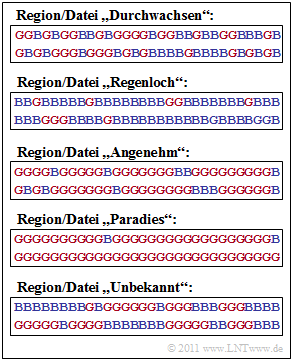Exercise 1.1: Entropy of the Weather
A weather station queries different regions every day and receives a message $x$ back as a response in each case, namely
- $x = \rm B$: The weather is rather bad.
- $x = \rm G$: The weather is rather good.
The data were stored in files over many years for different regions, so that the entropies of the $\rm B/G$–sequences can be determined:
- $$H = p_{\rm B} \cdot {\rm log}_2\hspace{0.1cm}\frac{1}{p_{\rm B}} + p_{\rm G} \cdot {\rm log}_2\hspace{0.1cm}\frac{1}{p_{\rm G}}$$
with the binary logarithm
- $${\rm log}_2\hspace{0.1cm}p=\frac{{\rm lg}\hspace{0.1cm}p}{{\rm lg}\hspace{0.1cm}2}\hspace{0.3cm} \left ( = {\rm ld}\hspace{0.1cm}p \right ) \hspace{0.05cm}.$$
Here, „lg” denotes the logarithm to the base $10$. It should also be mentioned that the pseudo-unit $\text{bit/inquiry}$ must be added in each case.
The graph shows these binary sequences for $60$ days and the following regions:
- Region „mixed”: $p_{\rm B} = p_{\rm G} =0.5$,
- Region „rainy”: $p_{\rm B} = 0.8, \; p_{\rm G} =0.2$,
- Region „pleasant”: $p_{\rm B} = 0.2, \; p_{\rm G} =0.8$,
- Region „paradise”: $p_{\rm B} = 1/30, \; p_{\rm G} =29/30$.
Finally, the file „Unknown” is also given, whose statistical properties are to be estimated.
Hinss:
- This task belongs to the chapter Discrete Memoryless Sources.
- For the first four files it is assumed that the events $\rm B$ and $\rm G$ are statistically independent, a rather unrealistic assumption for weather practice.
- he task was designed at a time when Greta was just starting school. We leave it to you to rename „paradise” to „hell”.
Questions
Solution
- $$H_{\rm D} = 0.5 \cdot {\rm log}_2\hspace{0.1cm}\frac{1}{0.5} + 0.5 \cdot {\rm log}_2\hspace{0.1cm}\frac{1}{0.5} \hspace{0.15cm}\underline {= 1\,{\rm bit/inquiry}}\hspace{0.05cm}.$$
(2) With $p_{\rm B} = 0.8$ and $p_{\rm G} =0.2$ , a smaller entropy value is obtained:
- $$H_{\rm R} \hspace{-0.05cm}= \hspace{-0.05cm}0.8 \cdot {\rm log}_2\hspace{0.05cm}\frac{5}{4} \hspace{-0.05cm}+ \hspace{-0.05cm}0.2 \cdot {\rm log}_2\hspace{0.05cm}\frac{5}{1}\hspace{-0.05cm}=\hspace{-0.05cm} 0.8 \cdot{\rm log}_2\hspace{0.05cm}5\hspace{-0.05cm} - \hspace{-0.05cm}0.8 \cdot {\rm log}_2\hspace{0.05cm}4 \hspace{-0.05cm}+ \hspace{-0.05cm}0.2 \cdot {\rm log}_2 \hspace{0.05cm} 5 \hspace{-0.05cm}=\hspace{-0.05cm} {\rm log}_2\hspace{0.05cm}5\hspace{-0.05cm} -\hspace{-0.05cm} 0.8 \cdot {\rm log}_2\hspace{0.1cm}4\hspace{-0.05cm} = \hspace{-0.05cm} \frac{{\rm lg} \hspace{0.1cm}5}{{\rm lg}\hspace{0.1cm}2} \hspace{-0.05cm}-\hspace{-0.05cm} 1.6 \hspace{0.15cm} \underline {= 0.722\,{\rm bit/inquiry}}\hspace{0.05cm}.$$
(3) In the file „pleasant” the probabilities are exactly swapped compared to the file „rainy” . However, this swap does not change the entropy:
- $$H_{\rm A} = H_{\rm R} \hspace{0.15cm} \underline {= 0.722\,{\rm bit/Anfrage}}\hspace{0.05cm}.$$
(4) With $p_{\rm B} = 1/30$ and $p_{\rm G} =29/30$ , the information contents are as follows:
- $$I_{\rm B} \hspace{0.1cm} = \hspace{0.1cm} {\rm log}_2\hspace{0.1cm}30 = \frac{{\rm lg}\hspace{0.1cm}30}{{\rm lg}\hspace{0.1cm}2} = \frac{1.477}{0.301} \hspace{0.15cm} \underline {= 4.907\,{\rm bit/inquiry}}\hspace{0.05cm},$$
- $$I_{\rm G} \hspace{0.1cm} = \hspace{0.1cm} {\rm log}_2\hspace{0.1cm}\frac{30}{29} = \frac{{\rm lg}\hspace{0.1cm}1.034}{{\rm lg}\hspace{0.1cm}2} = \frac{1.477}{0.301} \hspace{0.15cm} \underline {= 0.049\,{\rm bit/inquiry}}\hspace{0.05cm}.$$
(5) The entropy $H_{\rm P}$ is the average information content of the two events $\rm B$ and $\rm G$:
- $$H_{\rm P} = \frac{1}{30} \cdot 4.907 + \frac{29}{30} \cdot 0.049 = 0.164 + 0.047 \hspace{0.15cm} \underline {= 0.211\,{\rm bit/inquiry}}\hspace{0.05cm}.$$
- Although (more precisely: because) event $\rm B$ occurs less frequently than $\rm G$, its contribution to entropy is greater.
(6) Statements 1 and 3 are correct:
- $\rm B$ and $\rm G$ are indeed equally likely in the „unknown” file: the $60$ symbols shown divide into $30$ times $\rm B$ and $30$ times $\rm G$.
- However, there are now strong statistical ties within the temporal sequence. Long periods of good weather are usually followed by many bad days in a row.
- Because of this statistical dependence within the $\rm B/G$& sequence $H_\text{U} = 0.722 \; \rm bit/inquiry$ is smaller than $H_\text{D} = 1 \; \rm bit/inquiry$.
- $H_\text{D}$ is at the same time the maximum for $M = 2$ ⇒ the last statement is certainly wrong.
